Abstract
This paper addresses the event-triggered Nash equilibrium-seeking problem for non-cooperative games played by heterogeneous multi-agent systems. Unlike homogeneous multi-agent systems, heterogeneous multi-agent systems consist of agents with different dynamic structures, making it difficult to design control schemes and construct event-triggering conditions for such systems. In this paper, a novel centralized event-triggered Nash equilibrium-seeking strategy and a novel decentralized event-triggered Nash equilibrium-seeking strategy are proposed. The corresponding centralized and decentralized event-triggering conditions are derived. The convergence properties of the proposed centralized and decentralized strategies are proved. Further theoretical analyses illustrate that Zeno behavior does not exist under the proposed strategies. Finally, the effectiveness and efficiency of both centralized and decentralized strategies are presented through numerical experiments. The experimental results illustrate that under both strategies, heterogeneous multi-agent systems achieve the Nash equilibrium successfully, and the communication consumption among agents is significantly reduced.
Keywords:
Nash equilibrium seeking; event triggering; heterogeneous multi-agent systems; Zeno behavior MSC:
91A10
1. Introduction
In recent years, game theory has been adopted in various application fields, such as control of unmanned systems [1], multi-agent exploration policies [2], collective decision making [3], communication networks [4], and cooperative advertising strategy [5]. As an important part of game theory, the Nash equilibrium (NE)-seeking problem within multi-agent systems (MASs) has attracted increasing interest among scholars in multi-agent communities [6,7,8,9,10,11,12]. For example, in [6], Ye et al. tackled the distributed NE-seeking problem with constraints on control inputs by introducing a series of consensus-based strategies. In [10], Hua et al. focused on the generalized NE-seeking problem, which concerns the action constraints of the agents. An NE-seeking problem within MASs with strongly connected switching networks was considered by He et al. in [11]. Additionally, Tan et al. addressed an NE-seeking problem with the payoff functions and actions of agents unknown to each other in [12].
In the studies mentioned above, the NE is achieved through continuous-time communication. However, in practice, due to physical limitations, it is often necessary for mobile robots and other autonomous agents to implement controllers that do not depend on continuous-time communications [13,14,15]. It is a widely accepted fact that by introducing an event-triggered mechanism or a periodic sampling scheme, the communication consumption is effectively reduced. Thus, event-triggered mechanisms have attracted tremendous attention [16,17,18]. Many scholars have made efforts to replace continuous communication by introducing event-triggered mechanisms into NE-seeking strategies in recent years [19,20,21,22]. For example, Shi et al. developed an event-triggered strategy to compute the NE in aggregative games in [20]. Another event-triggered strategy was proposed by Shi et al. to solve the generalized NE-seeking problem of networked non-cooperative games in [21]. Those strategies are semi-decentralized. They require agents to have access to certain global information, such as the aggregate value of aggregative games or complete decision information. In [22], for non-cooperative games, Wang et al. proposed a decentralized event-triggered NE-seeking strategy that relies on partial decision information of each agent, such as local action and the estimation of neighbors of an agent.
In most of the above-mentioned studies, the authors studied homogeneous MASs, in which the dynamics of the agents are the same. Specifically, those strategies are designed exclusively for homogeneous MASs that contain only single-integrator or only double-integrator agents. However, this situation is a special case. Heterogeneous MASs, with different dynamic structures or identical dynamic structures but different parameters, are encountered in various applications [23,24,25,26,27,28]. According to [26], there are typically two types of heterogeneous MASs. The first type consists of agents with identical system structures but different parameters. For example, in [27], Li et al. developed an adaptive fuzzy containment control method for nonlinear MASs with time-delayed input. The followers in the MASs have identical system structures but different parameters. The second type of heterogeneous MASs consists of agents with non-identical system structures. For example, in [28], He and Huang considered the NE-seeking problem for high-order-integrator agents. If a multi-agent system consists of single- and double-integrator agents simultaneously, then the multi-agent system is deemed as a second-type heterogeneous multi-agent system. Unlike in the field of game theory, the implementation of an event-triggered mechanism for heterogeneous MASs has long been explored in other scientific fields, such as group consensus [29,30,31,32,33]. For example, in [32], combinational measurements were introduced to handle the pinning exponential synchronization of complex networks. In [33], Li et al. designed a fully distributed event-triggered pinning control scheme to address the group consensus problem for heterogeneous MASs with cooperative–competitive interaction.
Driven by the above discussion, this paper aims to design event-triggered NE-seeking strategies for non-cooperative games played by heterogeneous MASs with both single- and double-integrator agents. In comparison to existing works, the main contributions of this paper are presented as follows.
- Event-triggered NE seeking for non-cooperative games played by heterogeneous MASs comprising both single- and double-integrator agents is studied in this paper. Compared with conventional NE seeking for homogeneous MASs, the NE-seeking problem addressed in this paper is conducted by heterogeneous MASs, which consist of agents with varying dynamic structures, and it introduces an event-triggered mechanism to reduce communication consumption.
- A novel centralized event-triggered NE-seeking (CETNES) strategy and a novel decentralized event-triggered NE-seeking (DETNES) strategy are proposed to address the event-triggered NE-seeking problem for heterogeneous MASs. The corresponding centralized and decentralized event-triggering conditions are derived. The proposed CETNES and DETNES strategies successfully solve the NE-seeking problem for heterogeneous MASs and significantly reduce communication consumption.
- The convergence properties of both the CETNES and DETNES strategies are proved through Lyapunov stability theory. The nonexistence of Zeno behavior for both the CETNES and DETNES strategies is also proved.
The remaining part of this paper is organized as follows. In Section 2, some preliminaries concerning graph theory and mathematical notations are provided. Additionally, the formulation for the NE-seeking problem for non-cooperative games played by heterogeneous MASs is also presented in Section 2. In Section 3, the CETNES and DETNES strategies are proposed. Specifically speaking, in Section 3.1, a novel CETNES strategy is proposed, and detailed theoretical analyses of the CETNES strategy are presented. In Section 3.2, a novel DETNES strategy is designed to address the NE-seeking problem in a fully distributed manner, and detailed theoretical analyses of the DETNES strategy are presented. Moreover, in Section 4, the efficiency and efficacy of the proposed strategies are illustrated through numerical experiments. Finally, the conclusion is provided in Section 5.
2. Preliminaries and Problem Formulation
In this section, to lay the foundation for further investigation, some preliminaries concerning mathematical notation and graph theory are provided. Additionally, the formulation of the NE-seeking problem in non-cooperative games played by heterogeneous MASs is presented.
2.1. Mathematical Notation
In this paper, the notation for denotes a diagonal matrix with diagonal elements , respectively. Furthermore, denotes the minimum eigenvalue of a symmetric and real matrix , and . Moreover, denotes the 2-norm of a matrix or vector and the Kronecker product is denoted by ⊗ [34].
2.2. Graph Theory
Consider as the communication topology in non-cooperative games that contain n agents. The set of nodes is denoted by , the set of unordered pairs is defined as , the adjacency matrix is , where , the in-degree of the ith node is denoted by , and the in-degree matrix is denoted as , where . Moreover, the Laplacian matrix is [35].
2.3. Problem Formulation
Consider non-cooperative games played by heterogeneous MASs with m single-integrator agents and double-integrator agents. The dynamics of the heterogeneous agents are denoted as
where ; ; ; and . In addition, , , and denote the position, velocity, and control input for agent i, respectively.
Remark 1.
Before proceeding, in order to simplify complicated computations, it is necessary to point out that the position, velocity, and control input considered in this paper are scalars. In other words, , , and belong to 1-dimensional space. Nevertheless, it is easy to extend the main results in this paper to n-dimensional space by adopting the Kronecker product.
The cost function of agent i is for both single-integrator and double-integrator agents, where denotes the position set of all the n agents. The NE is given by
for , and .
In order to investigate the convergence properties, the following assumptions are introduced [6].
Assumption 1.
There exists a graph that denotes the communication topology of the n agents, and is undirected and connected.
Assumption 2.
For all , there is a positive constant m such that
where vector , with .
Assumption 3.
The partial derivative of cost function for each agent is globally Lipschitz, which means that there exists a positive constant such that
Remark 2.
It is obtained from Assumption 2 that for each fixed , is strongly convex [6]. In addition, it is derived from Assumptions 2 and 3 that the NE of the non-cooperative game is unique and the positions of agents are at the NE if and only if [36].
3. Main Results
In this section, the CETNES and DETNES strategies for non-cooperative games played by heterogeneous MASs are proposed for the first time. The convergence properties of the proposed strategies are obtained by utilizing Lyapunov stability theory. Furthermore, for both the CETNES and DETNES strategies, the nonexistence of Zeno behavior is proved.
3.1. CETNES Strategy
Suppose that, when adopting the CETNES strategy, all the agents update control input and exchange information with their neighbors at the same centralized event-triggering time instant. Consider as the kth centralized event-triggering time instant for all agents. For heterogeneous MASs, when , the CETNES strategy is proposed as
where denotes the local estimation of of agent i. Moreover, for the double-integrator agents, r is a positive parameter to be determined. For all agents, is a positive parameter to be determined. In addition, is the element of the adjacency matrix on the ith row and the jth column.
In this subsection, for agent i, to measure the difference between its own estimation and the actual value of agents position state vector at time t, a vector-valued function is introduced as
The event-triggered mechanism for the CETNES strategy is determined by a vector-valued function , and is defined as
where , with denoting an n-dimensional column vector whose elements are 1, and . In addition, , and .
The event-triggering condition is based on the value relation between and . When the event-triggering condition is satisfied, the event is triggered. Then, the next event-triggering time instant is reached. The centralized event-triggering condition is given as
where is a positive parameter to be determined.
Remark 3.
Compared with the NE-seeking strategy in [6], the proposed CETNES strategy does not require continuous-time information exchange among neighboring players. Therefore, the proposed CETNES strategy reduces the communication consumption.
The convergence properties of the proposed CETNES strategy are given by the following theorem.
Theorem 1.
Proof of Theorem 1.
Firstly, based on the CETNES strategy (4), when , the dynamics of the heterogeneous MASs are formulated as
Before proceeding, some notation is introduced for convenience. Let and denote the estimations of single-integrator and double-integrator agents, respectively. Let and denote the position vectors of single-integrator and double-integrator agents, respectively. Moreover, let and . Therefore, the corresponding vector form of (6) is given as
where , and matrix A is defined as for . In addition, and are defined as
To prove Theorem 1, the Lyapunov candidate function is given as
where
with matrix defined as . From Assumption 1, one knows that is connected and undirected. Hence, is symmetric and semi-positive definite. In addition, A is a semi-positive definite diagonal matrix. Hence, is symmetric and semi-positive definite. Additionally, in [37], it is proved that is a non-singular matrix for a connected and undirected graph. Therefore, matrix is symmetric and positive definite. Define matrix as . By Assumption 1, is also a symmetric positive definite matrix [6]. It is evident that and . Hence, . Therefore, if , then Theorem 1 is proved.
The time derivative of is given as
where . Since , one further has
Under Assumption 2, one has . Moreover, under Assumption 3, one obtains , where is the Lipschitz constant of . Therefore, , where for . Hence,
By Assumption 3, one has . Therefore, . Moreover, since , one has . In addition, . Hence, one obtains
Adding inequalities (11) and (13), one has
Based on Lyapunov stability theory, one knows that if inequality is proved, then Theorem 1 is proved. By observing inequality (14), one sees that there are negative terms and positive terms in inequality (14). In addition, inequality (14) is too complicated to analyze . Therefore, it needs to be simplified. For further investigation, the Young’s inequality [38] is introduced as
By reformulating the positive terms , , and , inequality (14) is reformulated as
where , and are positive constants to be determined, and constant h is defined as for convenience in algebraic computation. In addition,
By Assumption 3, it is derived that
where for . Moreover, under the event-triggering condition (5), one has . Therefore, inequality (15) is reformulated as
For convenience in algebraic computation, define parameters , and as
Then, one obtains
From inequality (16), one sees that if one can prove that there exists control parameters , r, and that guarantee and , then one obtains and Theorem 1 is proved.
First, we prove that there exists a positive control parameter r that guarantees . Since m, l, and h are positive constant, one obtains that there exist positive and that guarantee . For fixed and , define a positive constant that makes . It is derived that
Hence, for any , inequality holds.
Then, for a fixed r, since h is a positive constant and , one obtains that there exists a positive that guarantees . It is derived that .
Moreover, we prove that for fixed , , , and r, there exists a positive control parameter r that guarantees . For fixed , , , and r, define a positive constant that makes . It is derived that
Hence, for any , inequality holds.
Finally, we prove that for fixed , , , r, and , there exists a positive control parameter r that guarantees . For fixed , , , r, and , define a positive constant that makes . It is derived that
Hence, for any , inequality holds. Thus, for , . Hence, with , it is derived that .
Therefore, for properly chosen , and , under the event-triggering condition (5), if , then . In addition, following the Proof of Theorem 1, it is evident that is positive definite. Through Lyapunov stability theory [39], one obtains that the NE is achieved asymptotically, and , , and as . Thus, the proof is complete. □
Theorem 2.
Proof of Theorem 2.
If the lower bound of the inter-event time interval can be determined and inequality is always satisfied, then Theorem 2 is proved. Since the centralized event-triggering condition is based on the value relation between and , we investigate the time derivative of . For , one has . Hence,
where c is a positive constant defined as . Moreover, by Assumptions 2 and 3, it is derived that
where for . From Equation (9), it is derived that
Since , one further has
From Equation (10), it is derived that . Hence, one obtains
By observing inequalities (17) and (18), one sees that inequalities (17) and (18) consist of similar terms , , and with different coefficients. Therefore, a value relation between and is established. Define as and as . Thus, one obtains
Hence,
where . Moreover, as proved in Theorem 1, . Hence, for , . Thus, one obtains
where is a positive constant for . Hence,
Furthermore, under the event-triggering condition (5), for , . Therefore, . Consider the next event-triggering time instant , one has . Then, it is derived that
Thus, the lower bound of the inter-event time interval is summarized as
which proves the nonexistence of Zeno behavior. □
3.2. DETNES Strategy
As presented above, the CETNES strategy (4) demands global information to determine whether the condition (5) is satisfied. However, in physical implementations, agents in MASs may not have access to global information. In this subsection, a DETNES strategy is proposed to solve the NE-seeking problem in a fully distributed manner. By adopting the DETNES strategy, each agent determines its own event-triggering time instants only based on local information and information from its neighbors. Let denote the kth event-triggering time instant of agent i. For agent i, when , the DETNES strategy is proposed as
where denotes the latest event-triggering time instant of agent j when .
Before proceeding, some distributed measurements are introduced to construct the event-triggering condition for the DETNES strategy (19). The definitions of several decentralized measurements are given as
and
where denotes the set of neighbors for agent i.
Define and . For agent i, the elements of measurement and are given as
and
For agent i, define a decentralized measurement as
with the corresponding elements being
Thus, the decentralized event-triggering condition for agent i is given as
The transmission of information and the updating of the controller for agent i, along with the decentralized measurements and under the event-triggered mechanism, are presented in Figure 1.

Figure 1.
Event-triggered mechanism for agent i under DETNES strategy.
Remark 4.
Unlike measurements such as and , and are computable for agent i without utilizing global information. Therefore, the DETNES strategy (19) solves the NE-seeking problem for non-cooperative games played by heterogeneous MASs in a fully distributed manner.
The convergence property of the DETNES strategy (19) is given by the following theorem.
Theorem 3.
Proof.
The detailed proof is presented in Appendix A. □
Theorem 4.
Proof.
The detailed proof is presented in Appendix B. □
4. Numerical Experiments and Results
In this section, some numerical experiments are conducted to illustrate the efficiency and efficacy of the proposed CETNES strategy (4) and DETNES strategy (19).
Consider a heterogeneous multi-agent system consisting of six agents, in which agents , and 5 are single-integrator agents and agents , and 6 are double-integrator agents. As shown in Figure 2, the corresponding Laplacian matrix of is given as
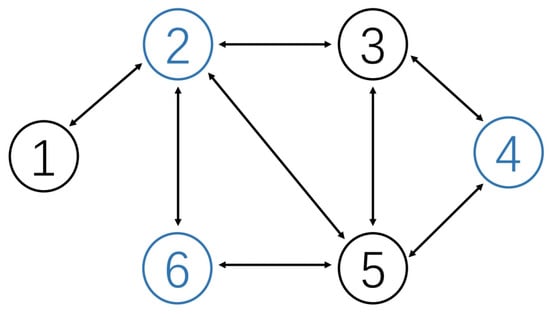
Figure 2.
Communication topology of heterogeneous multi-agent system consisting of 6 agents, in which agents , and 5 are single-integrator agents and agents , and 6 are double-integrator agents.
The cost functions of the agents are defined as
where , and are constants. Set the corresponding constants as , , and . Let ; the NE is obtained as . Moreover, for both CETNES and DETNES strategies, the initial states of the agents are set as and . In addition, control parameters and r are set as and , respectively. One can verify that the cost functions (21) satisfy Assumptions 2 and 3, and that the parameters and r satisfy and .
4.1. Experiment Results of CETNES Strategy
In this subsection, numerical experiments on the NE-seeking problem of non-cooperative games (21) with the CETNES strategy (4) are conducted. The corresponding experiment results are presented in Figure 3 and Figure 4, and Table 1.
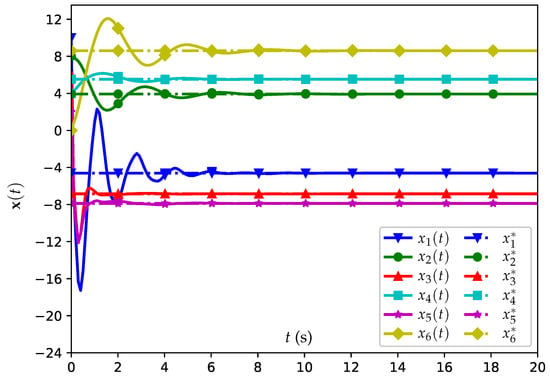
Figure 3.
Position trajectories of all agents when using the CETNES strategy (4) with , where denotes the NE for agent i.
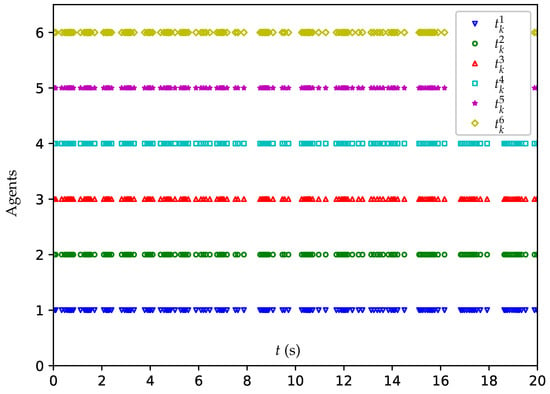
Figure 4.
Triggering time sequences of all agents when using the CETNES strategy (4) with .

Table 1.
Comparison of CETNES strategy (4) with different values of .
The position trajectories of all agents when using the CETNES strategy (4) with are illustrated in Figure 3. The corresponding centralized triggering time sequences of all agents are illustrated in Figure 4.
From Figure 3, one sees that, driven by the CETNES strategy (4), the heterogeneous multi-agent system successfully converges to the theoretical NE , as denoted by the dashed lines. Moreover, as illustrated in Figure 4, Zeno behavior does not occur when using the CETNES strategy (4).
Additionally, several numerical experiments of the CETNES strategy (4) with different values of are also conducted, and the corresponding results are presented in Table 1. From Table 1, one sees that, with a larger value of , there are more trigger events. In addition, it is evident that, as increases, the minimum and maximum inter-event time intervals also increase.
4.2. Experiment Results of DETNES Strategy
In this subsection, numerical experiments on a non-cooperative game (21) with the DETNES strategy (19) are conducted. The corresponding experiment results are presented in Figure 5 and Figure 6. The initial states and corresponding parameters are set to be the same as those in Section 4.1.
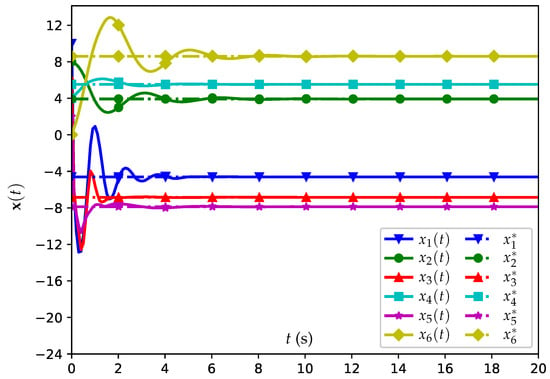
Figure 5.
Position trajectories of all agents when using the DETNES strategy (19) with , where denote the NE for agent i.
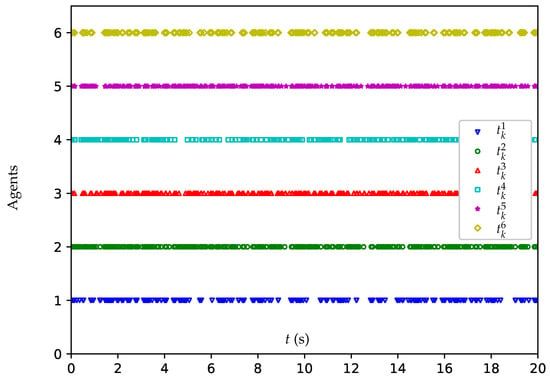
Figure 6.
Triggering time sequences of all agents when using the DETNES strategy (19) with .
4.3. Comparative Experiments
In this subsection, comparative experiments are conducted between the CETNES strategy (4), the DETNES strategy (19), and the periodic sampling control (PSC) strategy. The PSC strategy is based on the method presented in [28]. In [28], He and Huang introduced an NE-seeking strategy for homogeneous MASs consisting of agents with high-order integrator dynamics. Suppose that, under the PSC strategy, all agents periodically transmit their information to their neighbors at , where is a constant. Then, for agent i, when , a PSC strategy is formulated as follows:
where is a fictitious output, which is defined as
By introducing the fictitious output , the PSG strategy (22) ensures that double-integrator agents achieve consensus not only at the position level but also at the velocity level.
In the comparative experiment, the CETNES, DETNES, and PSG strategies are applied to solve the same NE-seeking problem in Section 4.1 and Section 4.2. For the three strategies, the parameters r and , as well as the initial states, are set identical to those in Section 4.1 and Section 4.2. Moreover, NE is achieved when . Hence, is chosen as the error that measures the convergence performance of the NE-seeking strategies.
Firstly, several experiments using the PSC strategy (22) with different values of are conducted to find the feasible sampling gap. The corresponding results are presented in Figure 7 and Table 2.

Figure 7.
Trajectories of of PSC, CETNES, and DETNES strategies with and different .

Table 2.
Convergence performance of PSG with different .
From Figure 7a,b, it is evident that when the CETNES and DETNES strategies achieve NE successfully, the PSC strategy (22) does not converge and fails to achieve the NE when s and s. Moreover, from Table 2, it can be seen that for the PSC strategy (22) to work, the sampling gap needs to be small enough. Therefore, the sampling gap is set to 0.01 s.
Additionally, comparative experiments between the CETNES, DETNES, and PSC strategies are conducted with and s. The corresponding results are presented in Figure 8 and Table 3.
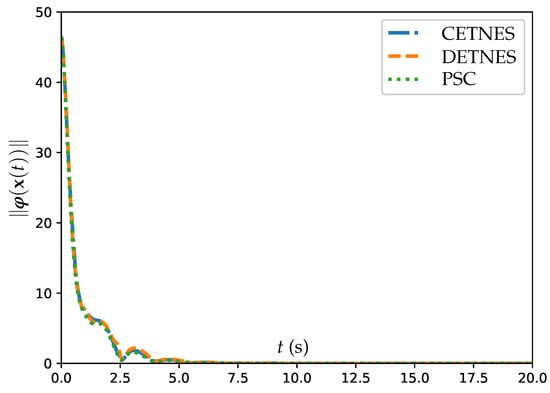
Figure 8.
Trajectories of synthesized by the PSC, CETNES, and DETNES strategies with and s.

Table 3.
Comparison between PSG, CETNES, and DETNES strategies with and s.
In addition, to investigate the influence of parameter , another comparative experiment is conducted with and the corresponding results are presented in Table 4. From Table 4, the differences in communication costs for the three strategies are apparent. For the CETNES strategy, the number of trigger events amounts to 144. In contrast, for the DETNES strategy, the number of trigger events for agents varies from 178 to 550 due to the distributed nature. As for the PSG strategy, the periodic sampling time remains 2000. Compared with the experiment results when , it is evident that the number of trigger events increases as decreases. Moreover, due to the centralized event-triggered mechanism, for the same , the communication consumption of the CETNES strategy is lower than the DETNES strategy. However, the DETNES strategy has a broader application scenario, as it does not rely on centralized communication or control.

Table 4.
Comparison between PSG, CETNES, and DETNES strategies with and s.
5. Conclusions
In this paper, the event-triggered NE-seeking problem for non-cooperative games in heterogeneous MASs has been tackled. To solve the NE-seeking problem, novel CETNES and DETNES strategies have been proposed. Theoretical analyses have illustrated the convergence properties of both the CETNES and DETNES strategies, ensuring that both strategies lead to the desired NE without exhibiting Zeno behavior. Through numerical experiments, the effectiveness and efficiency of the proposed strategies have been validated. The experimental results illustrate that both the CETNES and DETNES strategies not only successfully achieve the Nash equilibrium but also significantly reduce the communication consumption among agents. In this paper, the constraints on the agents’ actions are not considered. In practical engineering, heterogeneous MASs may encounter a variety of limitations, and due to their heterogeneous nature, these constraints are more difficult to handle. Generalized (i.e., constrained) Nash equilibrium seeking for heterogeneous MASs may be investigated in our future work.
Author Contributions
Conceptualization, L.H.; methodology, L.H. and H.C.; software, L.H.; validation, H.C. and Y.Z.; formal analysis, H.C. and L.H.; investigation, H.C. and L.H.; resources, L.H. and Y.Z.; data curation, L.H.; writing—original draft preparation, L.H.; writing—review and editing, L.H. and Y.Z.; visualization, L.H. and Y.Z.; supervision, H.C. and Y.Z.; project administration, Y.Z.; funding acquisition, H.C. All authors have read and agreed to the published version of the manuscript.
Funding
This research was supported by the China National Key R&D Program (with number 2022ZD0119602), the National Natural Science Foundation of China (with number 62376290), and Natural Science Foundation of Guangdong Province (with number 2024A1515011016).
Data Availability Statement
Data are contained within the article.
Acknowledgments
The authors wish to express their sincere thanks to Sun Yat-sen University for its support and assistance in this study.
Conflicts of Interest
The authors declare no conflicts of interest.
Abbreviations
The following abbreviations are used in this paper:
| NE | Nash equilibrium |
| MASs | Multi-agent systems |
| CETNES | Centralized Event-Triggered Nash Equilibrium Seeking |
| DETNES | Decentralized Event-Triggered Nash Equilibrium Seeking |
| PSC | Periodic sampling control |
Appendix A
Proof of Theorem 3.
Based on the DETNES strategy (19), the vector form of the dynamics of heterogeneous agents are formulated as
where . Choose the Lyapunov candidate function to be the same as (8) to analyze the convergence properties of the DETNES strategy (19). Following the Proof of Theorem 1, one has
Since in Equation (A1), , the main difference between Equations (12) and (A2) is the last two terms . Since , the last two terms of Equation (A2) are formulated as
Through Young’s inequality [38], it is derived that
Under the event-triggering condition (20), the following inequality is obtained:
Following the Proof of Theorem 1, similar to inequality (15), it is derived that
where, for convenience in algebraic computation, parameters , , and are defined as
with and are defined the same as those during the Proof of Theorem 1.
Choose and such that . Define a positive constant that makes . It is derived that
Thus, for , . Choose and such that and , then inequalities and hold. Since , it is evident that . Therefore, if , then .
Since and matrix is symmetric and positive definite, one has and , where denotes the maximum eigenvalue of matrix . Define a positive constant that makes ; it is derived that
Hence, for , . Finally, define a positive constant that makes ; it is derived that
Then, for , one has . With , it is derived that .
Therefore, for properly chosen , and , under the event-triggering condition (20), if , then . In addition, following the Proof of Theorem 1, it is evident that is positive definite. Through Lyapunov stability theory [39], one obtains that the NE is achieved asymptotically, and , , and as . Thus, the proof is complete. □
Appendix B
Proof of Theorem 4.
In what follows, the nonexistence of Zeno behavior for the DETNES strategy (19) is proved, which means holds for . For agent i when , one has
with
where is an n-dimensional row vector. Matrix is defined as for . Hence,
where . Following the proof process of Theorem 2, one has
where is defined the same as in the proof process of Theorem 2. On the basis of event-triggering condition (20), it is derived that . Thus, for , it is derived that
Then, one obtains the following inequality:
The proof is thus completed. □
References
- Yang, Y.; He, L.; Fan, Z.; Cheng, H. Distributed group cooperation with multi-mechanism fusion in an adversarial environment. Knowl. Based Syst. 2022, 258, 109953. [Google Scholar] [CrossRef]
- Jiang, F.; Cheng, H. Multi-agent bandit with agent-dependent expected rewards. Swarm Intell. 2023, 17, 219–251. [Google Scholar] [CrossRef]
- Jiang, F.; Cheng, H.; Chen, G. Collective decision-making for dynamic environments with visual occlusions. Swarm Intell. 2021, 16, 7–27. [Google Scholar] [CrossRef]
- Shokri, M.; Kebriaei, H. Leader-follower network aggregative game with stochastic agents’ communication and activeness. IEEE Trans. Autom. Control 2020, 65, 5496–5502. [Google Scholar] [CrossRef]
- Liu, J.; Li, C. Dynamic game analysis on cooperative advertising strategy in a manufacturer-led supply chain with risk aversion. Mathematics 2023, 11, 512. [Google Scholar] [CrossRef]
- Ye, M. Distributed Nash equilibrium seeking for games in systems with bounded control inputs. IEEE Trans. Autom. Control 2021, 66, 3833–3839. [Google Scholar] [CrossRef]
- Krstic, M.; Frihauf, P.; Basar, T. Nash equilibrium seeking in noncooperative games. IEEE Trans. Autom. Control 2012, 57, 1192–1207. [Google Scholar]
- Jing, C.; Wang, C.; Song, H.; Shi, Y.; Hao, L. Optimal asymptotic tracking control for nonzero-sum differential game systems with unknown drift dynamics via integral reinforcement learning. Mathematics 2024, 12, 2555. [Google Scholar] [CrossRef]
- Li, C.; Lin, W.; Chen, G.; Huang, T. Distributed generalized Nash equilibrium seeking: A singular perturbation-based approach. Neurocomputing 2022, 482, 278–286. [Google Scholar]
- Hua, Y.; Dong, X.; Li, Q.; Liu, F.; Yu, J.; Ren, Z. Dynamic generalized Nash equilibrium seeking for n-coalition noncooperative games. Automatica 2023, 147, 431–440. [Google Scholar]
- He, X.; Huang, J. Distributed Nash equilibrium seeking over strongly connected switching networks. Neurocomputing 2022, 533, 206–213. [Google Scholar] [CrossRef]
- Tan, S.; Wang, Y. A payoff-based learning approach for Nash equilibrium seeking in continuous potential games. Neurocomputing 2022, 468, 431–440. [Google Scholar] [CrossRef]
- Chen, J.; Pan, Y.; Zhang, Y. ZNN continuous model and discrete algorithm for temporally variant optimization with nonlinear equation constraints via novel TD formula. IEEE Trans. Syst. Man Cybern. Syst. 2024, 54, 3994–4004. [Google Scholar] [CrossRef]
- Wen, G.; Michael, Z.; Chen, Q.; Yu, X. Event-triggered master-slave sychronization with sampled-data communication. IEEE Trans. Circuits Syst. II Exp. Briefs 2016, 66, 304–308. [Google Scholar]
- Zhang, Y.; He, L.; Hu, C.; Guo, J.; Li, J.; Shi, Y. General four-step discrete-time zeroing and derivative dynamics applied to time-varying nonlinear optimization. J. Comput. Appl. Math. 2019, 347, 314–329. [Google Scholar] [CrossRef]
- Xu, L.-X.; Zhao, L.-N.; Ma, H.-J.; Wang, X. Observer-based adaptive sampled-data event-triggered distributed control for multi-agent systems. IEEE Trans. Circuits Syst. II Exp. Briefs 2020, 67, 97–101. [Google Scholar]
- Wang, D.; Lv, Y.; Zhang, K.; Fang, X.; Yu, X. Distributed Nash equilibrium seeking under event-triggered mechanism. IEEE Trans. Circuits Syst. 2021, 68, 3441–3445. [Google Scholar]
- Feng, G.; Fan, Y.; Wang, Y. Distributed event-triggered control of multi-agent systems with combinational measurements. Automatica 2013, 49, 671–675. [Google Scholar]
- Li, H.; Hao, Y.; Zhang, X. Offensive/defensive game target damage assessment mathematical calculation method between the projectile and target. Mathematics 2022, 10, 4291. [Google Scholar] [CrossRef]
- Shi, C.; Yang, G. Distributed Nash equilibrium computation in aggregative games: An event-triggered algorithm. Inf. Sci. 2019, 489, 289–302. [Google Scholar] [CrossRef]
- Shi, L.; He, W. Generalized Nash equilibrium seeking for networked noncooperative games with a dynamic event-triggered mechanism. Appl. Math. Model. 2023, 118, 39–52. [Google Scholar] [CrossRef]
- Wang, D.; Gao, Z.; Sheng, L. Distributed finite-time and fixed-time Nash equilibrium seeking for non-cooperative game with input saturation. Mathematics 2023, 11, 2295. [Google Scholar] [CrossRef]
- Feng, Y.; Zheng, W. Distributed group consensus of discrete-time heterogeneous multi-agent systems with directed communication topology. Appl. Math. Model. 2023, 118, 39–52. [Google Scholar]
- Feng, Y.; Zheng, W. Group consensus control for discrete-time heterogeneous first- and second-order multi-agent systems. IET Contr. Theory Appl. 2018, 12, 753–760. [Google Scholar] [CrossRef]
- Cao, M.; Shi, L.; Shao, J.; Xia, H. Asynchronous group consensus for discretime heterogeneous multi-agent systems under dynamically changing interaction topologies. Inf. Sci. 2018, 463, 282–293. [Google Scholar]
- Bao, G.; Ma, L.; Yi, X. Recent advances on cooperative control of heterogeneous multi-agent systems subject to constraints: A survey. Syst. Sci. Control Eng. 2022, 10, 539–551. [Google Scholar] [CrossRef]
- Li, Y.; Qu, F.; Tong, S. Observer-based fuzzy adaptive finite-time containment control of nonlinear multiagent systems with input delay. IEEE Trans. Cybern. 2021, 51, 126–137. [Google Scholar] [CrossRef]
- He, X.; Huang, J. Distributed Nash equilibrium seeking and disturbance rejection for high-order integrators over jointly strongly connected switching networks. IEEE Trans. Cybern. 2024, 54, 2396–2407. [Google Scholar] [CrossRef] [PubMed]
- Gao, H.; Shi, Y.; Qin, J.; Ma, Q.; Yu, K. On group synchronization for interacting clusters of heterogeneous systems. IEEE Trans. Cybern. 2017, 47, 4122–4133. [Google Scholar]
- Bassett, D.S.; Menara, T.; Baggio, G.; Pasqualetti, F. Stability conditions for cluster synchronization in networks of heterogeneous kuramoto oscillators. IEEE Trans. Control Netw. Syst. 2020, 7, 302–314. [Google Scholar]
- Wang, D.; Ma, H.; Liu, D.; Li, C. Centralized and decentralized event-triggered control for group consensus with fixed topology in continuous time. Neurocomputing 2015, 161, 267–276. [Google Scholar]
- Huang, T.; Zhou, B.; Liao, X.; Chen, G. Pinning exponential synchronization of complex networks via event-triggered communication with combinational measurements. Neurocomputing 2015, 157, 199–207. [Google Scholar]
- Zhang, C.; Li, K.; Ji, L.; Li, H. Fully distributed event-triggered pinning group consensus control for heterogeneous multi-agent systems with cooperative-competitive interaction strength. Neurocomputing 2021, 464, 273–281. [Google Scholar]
- Golub, G.; Loan, C.F. Matrix Computations, 4th ed.; John Hopkins Univesity Press: Baltimore, MD, USA, 2013; pp. 22–33. [Google Scholar]
- Diestel, R. Graph Theory, 5th ed.; Springer: Berlin/Heidelberg, Germany, 2017; pp. 1–33. [Google Scholar]
- Rosen, J.B. Existence and uniqueness of equilibrium points for concave n-person games. Econometrica 1965, 33, 520–534. [Google Scholar] [CrossRef]
- Ye, M.; Hu, G. Distributed Nash equilibrium seeking in multi-agent games under switching communication topologies. IEEE Trans. Cybern. 2018, 48, 3208–3217. [Google Scholar] [CrossRef] [PubMed]
- Bui, H. Weighted Young’s inequality and convolution theorems on weighted Besov spaces. Math. Nachr. 1994, 170, 25–37. [Google Scholar] [CrossRef]
- Khalil, H.K. Nonlinear Systems, 3rd ed.; Prentice Hall: Upper Saddle River, NJ, USA, 2002; pp. 111–181. [Google Scholar]
Disclaimer/Publisher’s Note: The statements, opinions and data contained in all publications are solely those of the individual author(s) and contributor(s) and not of MDPI and/or the editor(s). MDPI and/or the editor(s) disclaim responsibility for any injury to people or property resulting from any ideas, methods, instructions or products referred to in the content. |
© 2025 by the authors. Licensee MDPI, Basel, Switzerland. This article is an open access article distributed under the terms and conditions of the Creative Commons Attribution (CC BY) license (https://creativecommons.org/licenses/by/4.0/).